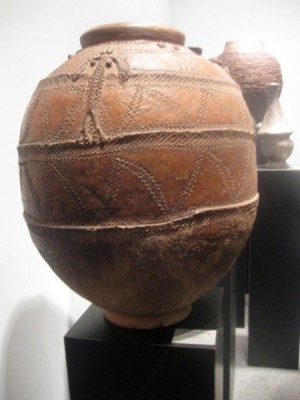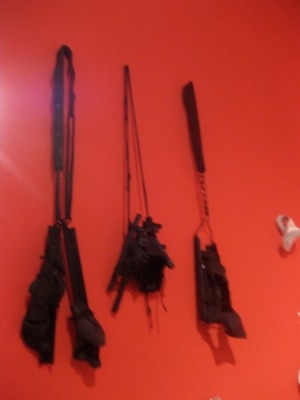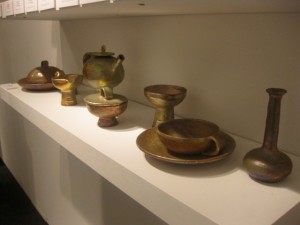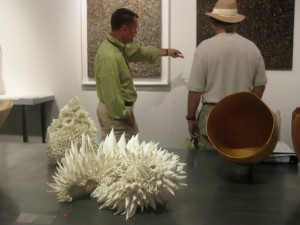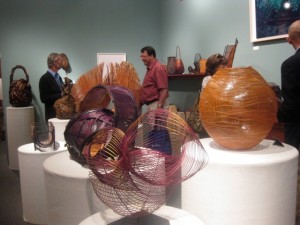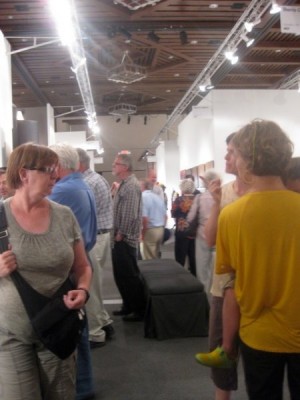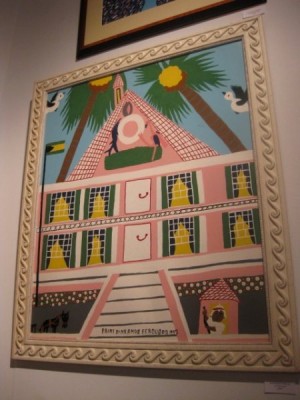
SoFa West In Year Three: The “New Paradigm” Here To Stay
Fairs are art dealings’ “new paradigm.” So 30-year veteran Chicago dealer Douglas Dawson told me at SoFa West Thursday, voicing a sentiment I heard through more than a dozen dealer interviews at the fair. “Hoping to identify new collectors is exactly why we’re here. We consider it advertising,” Dawson said of his appearance at SoFa West.
By Saturday afternoon, one sale had been achieved at Dawson’s booth: a $9500 (label price) African earthenware vessel had sold to an American museum, which the dealer declined to name (the work in the booth ranged from $3000-$22,000). In a trend of streamlined display visible among quite a few of the dealers, Dawson elected to showcase a deep display of only vessels, united by their age – from 50-70 years old – and provenance from sub-Saharan African countries including Mali, Nigeria, Burkina Faso, and Cameroon. These included ritual and shrine objects, as well as a beer storage vessel that incorporated fiber.
Cool despite the relative paucity of sales, Dawson stressed that art fairs are the first step in identifying a new buyer with whom follow-up contact is the second step in the “new paradigm’s” process of converting new clients.
And, judging by the crowds – a steady attendance in the halls, and outside on the patio where strangers shared tables to eat $7 Frito pies – this third year of a fair with an excellent display system and a strong dealer group was the charm. First-time SoFa West dealer Mindy Solomon, from St. Petersburg, FL, enthused about the education and savvy level of the visitors she had met. Showing in her booth Korean works on paper and ceramics, Solomon referenced museum shows including one of Korean Buncheong ceramics held at the Met, and Life in Ceramics: Five Korean Artists at the Fowler Museum at UC.L.A.. She said many booth visitors had seen the Met show – and said she liked to hear of museum-going experience among show clientele.
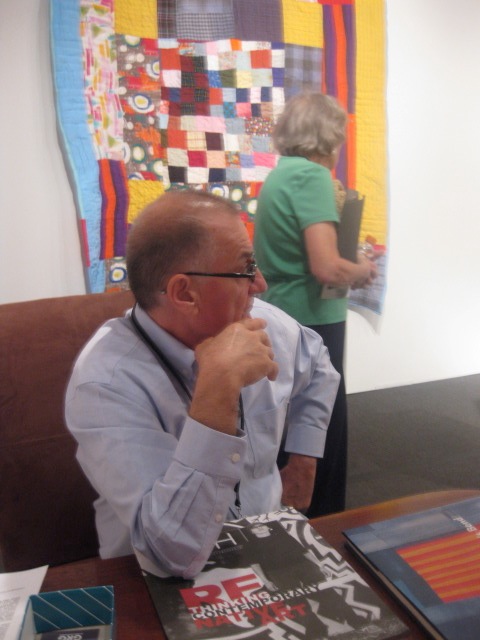
Tom Tavelli at the 222 Shelby Street booth
Tom Tavelli, director of 222 Shelby Street gallery, praised the show traffic as blockbuster, saying he’d seen more visitors “in two days than in two years” of gallery hours. Situated directly across the aisle from ceramics dealers Clark + Del Vecchio, and next to basketry dealer TAI, 222 Shelby hung Gee’s Bend quilts behind a table of Nino Caruso micaceous ceramic sculpture.
In a gamble that proved precocious (after a trial run at SoFa Chicago last November), the fair’s inclusion this year of dealers of outsider and folk art – The Intuit Show of Folk and Outsider Art – meant that even jaded “objects and functional art” snobs could go around and see paintings by iconic international “outsiders” such as Henry Darger and Bill Traylor, as well as emerging work shown by galleries in Austin and Berkeley.
The range included Carl Hammer of Chicago exhibiting Henry Darger, the late Chicago janitor whose epic 9000-page manuscript about the Vivien Girls included double-sided drawings of their serial adventures ($195k and $250k for the examples here); and “Red Dog” by outsider Bill Traylor ($350k). On a more accessible range, Galerie Bonheur of St. Louis showed some critically acclaimed paintings on cardboard by Bahamian artist Amos Ferguson ($6500-$12,000). From Yard Dog in Austin, or Ames in Berkeley, new work appeared at price points below $1000.
Admitting to some doubt at first as to whether outsider art would change the character of SoFa West, Jane Sauer told me she’d opposed the idea originally. But in the flesh it appeared quite differently: “It really is working. I like it,” she said.
Geoffrey Gorman, a top-selling artist for Sauer who does the other SoFa fairs, is a former Santa Fe art consultant whose figurative animal sculpture, such as his fetching anteater , has been included in coming September’s Guangzhou South Korea biennale (opening 9/15).
The playfully hung booth from New York jewelry dealer Charon Kransen offered work in jewelry that reveals the extension of that medium beyond precious metals and gemstones. Kransen, saying that education is key to cultivating new clients, offered that fair-exhibiting, any-fair-exhibiting, entails at minimum a five-year commitment. His key message? “That any material used in jewelry can be considered to be ‘precious.’ It all depends how you treat it.” That would go from recycled leather necklaces by the Mexican artist Jorge Manila, to wooden collars by Norwegian jeweler Liv Blavarp ($25k).
“(The fair) feels really optimistic,” Mark Del Vecchio told me, pointing to a cohesive group of dealers and an upbeat energy that he said carried palpably from set-up through opening through Saturday (my last visit).
Spectacular work shown at Clark + Del Vecchio included a feature of the Danish porcelain artist, Bodil Manz, reflecting the dealers’ critical eyes – and probable market impact. They found Manz’s work while Garth Clark was jurying a ceramics competition in Croatia years ago; her porcelain forms with continuous walls and architectonic decals have the shock of extraordinary. By Saturday two of four of her large pieces ($9,500) were marked sold – and four of the cup-sized works sold out opening night.
Eight Modern showed funky anime-driven ceramics by Bart Johnson, grouped in front of Johnson’s works on paper. With an excellent booth design, the dealers put Ted Larsen’s sculptural work on high so that it attracted your eye as you walked down the aisle.
Mindy Solomon, the St. Petersburg, FL gallerist exhibiting new Korean work, focused on three artists including Kang Ho Lee; with works priced in the $1500-$2500 range. “As a dealer I’m drawn to things not everyone else shows,” Solomon said, noting that fairs have been essential to her business, and have allowed her to spotlight many different facets of her program from photography by the de la Torres, to work such as this.
Directly opposite from Solomon’s booth was FLOW, a London gallery that innovated a sleek display of four translucent glass objects, alongside discrete displays of jewelry, wooden vessels and porcelain sculpture. It worked. Jerry Austin, said FLOW was having its first US fair venue here – and on opening night, had sold a porcelain sculpture by the Irish artist Nuala O’Donovan.
Indicating the busy crowd Thursday, Yolanda Farias of Carl Hammer Gallery, the driver behind the Intuit side of the fair, said, “This personally I love,” gesturing at the busy discussions and the Santa Fe-style fashions. Cassandra Straubing, an artist exhibiting with Bullseye Glass in Portland, said Bullseye was seeing a strong commission flow out of the fair – and like two other artists interviewed on the fair floor, was ready to talk to people about the work in the booth.
And the benefits extended evidently to Friday night’s openings and regular gallery show attendance here. Richard Barger of David Richard Contemporary said the gallery saw 120-plus people on Friday.
Among the edgiest of the booths was SWAIA’s Indian Market artists: a display of edgy new Native jewelry ranging from Pat Pruitt’s spiky cages for Tahitian pearls to Keri Ataumbi’s bracelet with magnetic scarabs; another booth in which fair visitors clustered to inquire about this new Native American jewelry far beyond turquoise.
The story, though, overall, was just how key fairs are to the art business now. When they’re good – and this can apparently mean that when they achieve even mixed-results, but exhibit strong work, and attract a good crowd, – the dealers say they feel good about it. That there are lots of choices in fairs remains obvious, too. Just ask about their upcoming schedules and the list quickly grows exhaustive: From Texas Contemporary to the Houston Fine Art Fair; the International Fine Arts and Antiques Fair in New York in November; SoFa Chicago in November, too. And so on. And so on.

Kato Yasukage at Joan Mirviss
Yolanda Farias of Carl Hammer said, “The old days when galleries did business on the telephone are over.”
And the new days?
“Art fairs,” she said. “And the Internet.”

